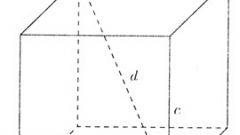Instruction
1
The concept of indefinite integral is derived from the concept of the integral of the function. The function F(x) is called the integral of the function f(x) if the entire domain of definition of F'(x) = f(x).
2
Any function with one argument can be no more than one derivative. However, primitive it is not. If the function F(x) is a primitive for f(x), the function F(x) + C, where C is any nonzero constant, is also a primitive for her.
3
Indeed, by the rule of dierentiation (F(x) + C)' = F'(x) + C' = f(x) + 0 = f(x). Thus, any primitive for f(x) looks like F(x) + C. This expression is called the indefinite integral of the function f(x) and is denoted ∫f(x)dx.
4
If the function is expressed through elementary functions, then its derivative is also always expressed through elementary functions. However, for the integral this is also incorrect. A number of simple functions such as sin(x^2) have indefinite integralsthat are not expressible using elementary functions. To integrate them only approximately, by numerical methods, however, such functions play an important role in some areas of mathematical analysis.
5
Simple formulas for the indefinite integrals are derived from the rules of differentiation. For example, ∫(x^2)dx = (x^3)/3, because (x^3)' = 3x^2. In General, for any n ≠ -1 it is true that ∫(x^n)dx = (x^(n+1))/(n+1).
When n = -1, this expression loses its meaning, however, the function f(x) = 1/x, however, integrable. ∫(1/x)dx = ∫dx/x = ln|x| + C. note that the function ln|x|, in contrast to the function ln(x), dened on the whole real line except zero, in the same way as the function 1/x.
When n = -1, this expression loses its meaning, however, the function f(x) = 1/x, however, integrable. ∫(1/x)dx = ∫dx/x = ln|x| + C. note that the function ln|x|, in contrast to the function ln(x), dened on the whole real line except zero, in the same way as the function 1/x.
6
If the functions f(x) and g(x) integrable, then their sum is also integrable, and ∫(f(x) + g(x)dx = ∫f(x)dx + ∫g(x)dx. If the function f(x) integrable, then ∫af(x)dx = a∫f(x)dx. These rules can be combined.
For example, ∫(x^2 + 2x + 1)dx = (x^3)/3 + x^2 + x + C.
For example, ∫(x^2 + 2x + 1)dx = (x^3)/3 + x^2 + x + C.
7
If ∫f(x)dx = F(x), then ∫f(x+a)dx = F(x+a) + C. This is called the summation under the sign of the differential of the constant term. Under the sign of the differential it is possible to sum and constant multiple: ∫f(ax)dx = F(ax)/a + C. Combining these two steps, we get: ∫f(ax + b)dx = F(ax + b)/a + C. for Example, if f(x) = sin(2x + 3) then ∫f(x)dx = -cos(2x + 3)/2 + C.
8
If an integrable function can be represented in the form f(g(x))*g'(x), for example, sin^2(x)*2x, this function is integrated by the method of variable substitution: ∫f(g(x))*g'(x)dx = ∫f(g(x)) dg(x) = F(g(x)) + C. This formula is derived from the formula of the derivative of a composite function: f(g(x))'= f'(g(x))*g'(x).
9
If an integrable function can be represented in the form u(x)*v'(x), then ∫u(x)*v'(x)dx = uv - ∫v(x)*u'(x)dx. This method of integration by parts. It is used when the derivative of u(x) is much simpler than that of v(x).
For example, let f(x) = x*sin(x). Here u(x) = x, v'(x) = sin(x), hence v(x) = -cos(x) and u'(x) = 1. Then ∫f(x)dx = -x*cos(x) - ∫(-cos(x))dx = sin(x) - x*cos(x) + C.
For example, let f(x) = x*sin(x). Here u(x) = x, v'(x) = sin(x), hence v(x) = -cos(x) and u'(x) = 1. Then ∫f(x)dx = -x*cos(x) - ∫(-cos(x))dx = sin(x) - x*cos(x) + C.













